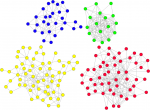
By: The Posts Author | Posted on: 11 Feb 21
Without further ado, let’s pick up where we left off last week! We ended the post on a series of questions, which we can now start to follow up on, and let’s start from one that focused on an outlier: Do people who have positive expectations from business see responsibility differently? We can examine that question by isolating the stories where there was particular emphasis on the potential of businesses. To save people the trouble of referring back to the previous blog in the series, this is what the overall pattern around responsibility looks like:
Without further ado, let’s pick up where we left off last week! We ended the post on a series of questions, which we can now start to follow up on, and let’s start from one that focused on an outlier: Do people who have positive expectations from business see responsibility differently? We can examine that question

By: The Posts Author | Posted on: 4 Feb 21
We are now at the stage where we start to dig into the patterns and ask what they might be telling us. Let’s start by looking at two triads that look at possibility and responsibility, involving similar factors from different angles. The first triad is more positively-oriented; it is an expectation of good things to come. It has three large clusters of stories close to individuals, governments, and at the centre, the latter suggesting a combination or collaboration of all three. Business is a minor outlier here. Responsibility, the core idea behind the second triad is a bit more
We are now at the stage where we start to dig into the patterns and ask what they might be telling us. Let’s start by looking at two triads that look at possibility and responsibility, involving similar factors from different angles. The first triad is more positively-oriented; it is an expectation of good things to come. It has three

By: The Posts Author | Posted on: 31 Jan 21
It is funny, when we think about networks, we think about groups, communities, systems, and other complex collections of interacting entities. Yet, the most popular social network metrics are “individual centralities”! Who is the most connected? Who is the best connected? Who is the hub? Who is the influencer? Who spans the most structural holes in the network? We are looking at complex interconnected systems yet we are focusing on individuals. Does this make sense? People playing key roles in organizations and communities are important, but not for what they do for themselves! They are important for how they weave
It is funny, when we think about networks, we think about groups, communities, systems, and other complex collections of interacting entities. Yet, the most popular social network metrics are “individual centralities”! Who is the most connected? Who is the best connected? Who is the hub? Who is the influencer? Who spans the most structural holes in the network? We are

By: The Posts Author | Posted on: 28 Jan 21
Before going into the meat of this section, let’s talk about triads and dyads a little bit, and the representation of patterns on them, so people know what they are looking at. A warning that this post is a bit longer than I intend to make them, partially because of this additional section in the beginning. Those of you familiar with SenseMaker are welcome to skip this paragraph and the next one, but I hope it will make this series more accessible to everyone who is not. As covered in the previous post, we asked people to share an action they
Before going into the meat of this section, let’s talk about triads and dyads a little bit, and the representation of patterns on them, so people know what they are looking at. A warning that this post is a bit longer than I intend to make them, partially because of this additional section in the beginning. Those of you familiar

By: The Posts Author | Posted on: 21 Jan 21
Almost every SenseMaker collection, no matter what it is, contains some garden-variety multiple-choice questions. These may appear simple, but they can often be deceptively tricky. They depend on multiple things, such as which categories are significant to our question (for example, might the patterns associated with children’s stories be different to those of adults?), or the balance of how many are too many. In return for our concern, these multiple-choice questions provide us with filters that allow us to look at the data from different perspectives (you will see that in future posts), as well as an at-a-glance setting for
Almost every SenseMaker collection, no matter what it is, contains some garden-variety multiple-choice questions. These may appear simple, but they can often be deceptively tricky. They depend on multiple things, such as which categories are significant to our question (for example, might the patterns associated with children’s stories be different to those of adults?), or the balance of how many

By: The Posts Author | Posted on: 14 Jan 21
This has been a year of experimentation in many things, including the report format. SenseMaker, despite its use for near-real-time feedback loops and continuous monitoring, is also often used in limited-time, one-off projects which are then followed by a report on that specific run, following a range of format. More often than not, this report is not considered a final offering but a sense-making artefact to feed into more collective processes and interpretation on the ground. This definitely has its uses and will probably never go away (we do live and practice in a yes/and world after all!) but for
This has been a year of experimentation in many things, including the report format. SenseMaker, despite its use for near-real-time feedback loops and continuous monitoring, is also often used in limited-time, one-off projects which are then followed by a report on that specific run, following a range of format. More often than not, this report is not considered a final

By: The Posts Author | Posted on: 7 Jan 21
It is 2021, and many of us don’t know quite what that entails. Most were very glad to see the back of 2020, and many colourful, expletive-filled goodbyes were said. As this happened, I and many others reminded ourselves that 2021 will be just as difficult, if not even more demanding. What a moment then to introduce new things! Can we still muster the energy to think about them? To me, the answer has to be “more than ever”. One of the reasons the transition from ’20 to ’21 has been so challenging is that we still don’t know what
It is 2021, and many of us don’t know quite what that entails. Most were very glad to see the back of 2020, and many colourful, expletive-filled goodbyes were said. As this happened, I and many others reminded ourselves that 2021 will be just as difficult, if not even more demanding. What a moment then to introduce new things! Can
- 1
- 2







